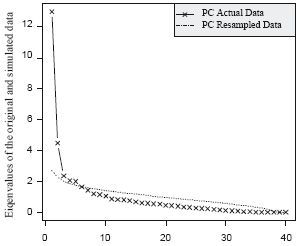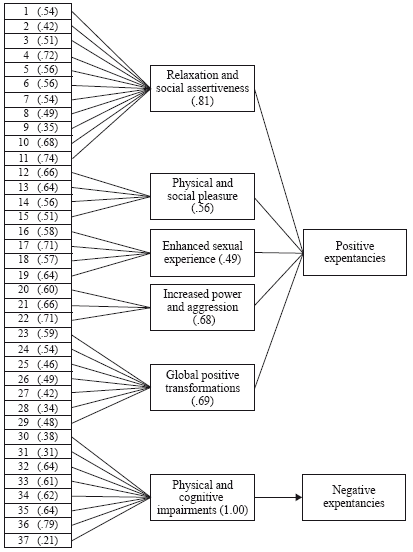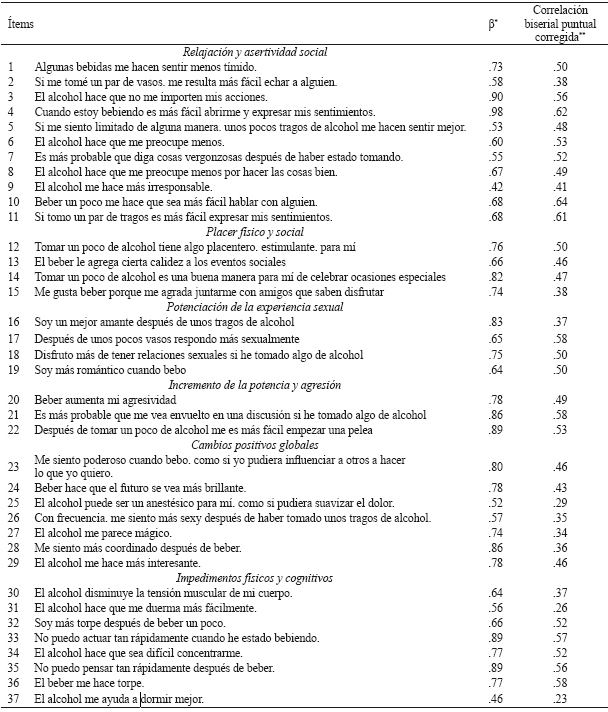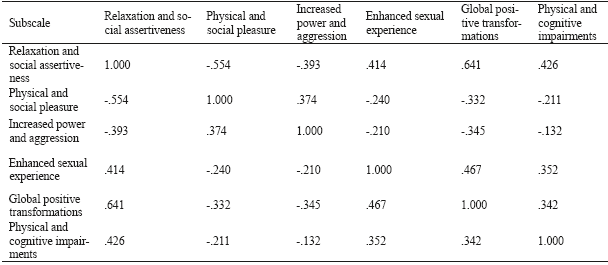INTRODUCTION
On a worldwide scale, alcohol consumption of university students represents a growing concern for Public Health, a fact that doesn't leave out Latin-American countries (World Health Organization [WHO], 2010). University students present a high prevalence of heavy episodic drinking, a kind of consumption that involves the intake of five or more drinks (one drink represents a beverage containing approximately 11 gr. of pure alcohol) in one occasion. This exposes them to immediate health consequences (traffic injuries, violence and increased criminality, unprotected sex, etc.), as well as to long term consequences, such as alcohol dependence (Karam, Kypri, & Salamoun, 2007; White & Hingson, 2014). In Argentina, a study developed by the Drugs National Observatory (Observatorio Nacional de Drogas, 2006) found that 86% of university students referred having consumed alcohol at least once, and that 25% had at least one episode of heavy drinking in the last year. Recent studies show that heavy episodic drinking extends to 35% of the university students in Mar del Plata city (Conde, Remaggi, & Cremonte, 2014). While an epidemiologic view allows us to determine this problem's magnitude, to design an effective intervention strategy it is important to know which other factors associate with alcohol consumption and if a change in those factors could be achieved in order to reduce it.
In recent years, the study of cognitive models to explain alcohol consumption has grown. One of these models is the Expectancy Theory, which understands that expectancies are individual beliefs related to behavior. People act according to what they believe that is going to happen as a result of performing a certain behavior or not.
People hold beliefs about the consequences of alcohol consumption, and when they expect positive consequences as a result of such consumption (positive expectancies), their motivation to consume will grow. On the contrary, people that consider the negative consequences of alcohol intake (negative expectancies) will be less motivated to consume (Jones, Corbin & Fromme, 2001).
The study of the expectancies towards alcohol consumption effects has proven to be useful in order to approach the psychosocial factors associated with consumption (Kouimtsidis, Stahl, West, & Drummond, 2014). Moreover, these expectancies are related to the age of onset of alcohol use (Leigh, 1989; Leigh & Stacy, 2004) and to different drinking patterns, such as the heavy episodic drinking (Fisher, Miles, Austin, Camargo Jr, & Colditz, 2007) and associated problems (Blume & Blume, 2013).
Among the developed instruments to empirically evaluate alcohol expectancies, the Alcohol Expectancy Questionnaire (AEQ) (Leigh, 1989) has been the most widely used. Even though earlier versions of this instrument focused just on the positive expectancies (Brown, Goldman, Inn, & Anderson, 1980), later adaptations such as the AEQ-A (Brown, Christiansen, & Goldman, 1987) include the evaluation of negative expectancies and were built upon transcriptions of phrases acquired in interviews to teenagers from 12 to 19 years old and item modifications of the AEQ, specifically constructed for young population.
The original version of the AEQ-A contains seven subscales: global positive transformations, enhanced or impeded social behavior, improved cognitive and motor abilities, enhanced sexuality, deteriorated cognitive and behavioral function, increased arousal and relaxation or tension reduction (Aas, 1993; Christiansen, Goldman, & Inn, 1982). Studies developed in different contexts have shown a diverse distribution of the subscales in comparison with the original questionnaire, varying in items quantity and structure (Aas, 1993; Christiansen et al., 1982; Herrân & Ardila, 2009; Kline, 1996; Miller, Smith, & Goldman, 1990; Perez-Aranibar, Van den Broucke, & Fontaine, 2005).
Considering expectancies' cultural variability, it is possible to find differences in their structure in dissimilar contexts (Galvez, 2009; Pérez-Aranibar et al., 2005). This fact justifies the need to replicate analyses, with the purpose of adapting instruments to each drinking context and identifying similarities with previous findings. To date, in Argentina only one AEQ-A validation process has been done, (Pilatti, Godoy, & Brussino, 2010) with a children and adolescents sample whose consumption practices are diferent to those of university students, usually exposed to higher risks.
Taking into account all of the above, the aim of this study is to analyze the psychometric properties (dimensionality, reliability and concurrent validity) of a previously adapted version of the AEQ-A in psychology students. Expectancies evaluation instruments such as this will allow the study of consumption related aspects.
METHOD
Participants
A systematic sample was gathered, consisting of 1076 psychology students from the National University of Mar del Plata city. This sample surpasses the recommended criteria to establish the factorial validity of a five subjects for item questionnaire (Norman, Streiner, & Tarrés, 1996).
The sample consisted of 83% females [CI 95% 79-86] and 17% males [CI 95% 14-21], with a mean age of 24.83 years [CI 95% 24.07-25.58] and an average typical consumption of 3.5 drinks for occasion [CI 95% 2.92-4.09].
Instruments
The version of the AEQ-A questionnaire used in this study was previously translated and linguistically adapted to Mar del Plata city's particular context (Lichtenberger, Marconato, & Cremonte, 2011). It consists of a self-report involving 40 items measured on a dichotomous scale (true/ false) that evaluates positive and negative expectancies in seven subscales (global positive transformations, enhanced or impeded social behavior, improved cognitive and motor abilities, enhanced sexuality, deteriorated cognitive and behavioral function, increased arousal and relaxation or tension reduction). In order to calculate the final score of each subscale, the scores of the items involved in each subscale must be added (true=1, false=0). Higher scores indicate higher expectancies about alcohol effects.
The instrument included sociodemographic data and an evaluation of heavy episodic drinking in the last month. This evaluation was conducted through one question about the consumption of five standard units on one occasion in the last month. To calculate standard units an indicative chart containing the quantity of standard units according to different beverage types was included in the questionnaire.
Procedure
Data were collected during lecture hours in the classrooms. If students were absent when the questionnaire was administered, collectors came back the following week. Participation was voluntary, no compensation was offered and there were only five refusals. At least two researchers were present when the questionnaire was applied in order to clear up doubts and resolve the issues that could arise. Once the questionnaire was completed, each participant was given a brochure containing information about assistance centers for alcohol related problems, as well as the research team contact information. This study was approved by the Ethics Committee of the Epidemiology National Institute Dr. J. H. Jara of Mar del Plata city.
The whole sample was randomly divided into two parts. In the first part, the structure (dimensionality) of the questionnaire was determined by an exploratory factor analysis. Because it is an instrument with dichotomous items, analyses were adjusted to a tetrachoric correlations matrix. The extraction was done by the maximum verisimilitude method with a normalized promax rotation, given the high level of correlation between dimensions. Additionally, a parallel analysis was conducted for n = 100 simulated samples.
The Subscales' internal consistency was evaluated through Kuder Richardson -20 coefficient (KR-20) and its confidence intervals were estimated at 95%; analyses to an item level were also conducted (factorial load and corrected point-biserial correlation). The degree of relation among the different dimensions was estimated through Spearman correlation coefficient (bilateral) for non-parametric data.
Later on, in the second part of the sample, a confirmatory factor analysis was performed on the found dimensions, using X2, Comparative Fit Index (CFI), Tucker-Lewis Index (TLI), Root Mean Square Error of Approximation (RMSEA), and Standardized Root Mean Square Residual (SRMR) as fit indices. The WLSMV robust estimator was used, indicated for non-parametric data (Brown, 2006). In addition to the six theoretical subscales, a second-order confirmatory factor analysis with two factors (positive and negative expectancies) was conducted.
In order to establish the questionnaire's concurrent validity, a prediction analysis of heavy episodic drinking was performed, considering each one of the expectancy subscales (adding each component item, true = 1, false = 0). With this purpose, different logistic regressions were performed. In each logistic regression, heavy episodic drinking (reference category = positive) was the outcome measure and the score in each one of the six expectancy subscales was the predictor variable.
Data processing and analysis was conducted with psych package, fa.parallel.poly y fa.poly functions (Revelle, 2012) and lavaan, cfa function (Rosseel, 2012) of R 3.2.3 software, ICalfa (Merino, 2015), and SPSS 17.0.
RESULTS
In this section, exploratory factor analysis results are presented, followed by the confirmatory factor analysis of the found dimensions. Finally, the concurrent validity of the questionnaire (heavy episodic drinking prediction) is presented.
Factorial structure
Data showed suitable properties for factor analysis (KMO = .86, Bartlett's sphericity test = 539.9, DoF= 78, p < .001). The solution was adjusted to six factors which had higher eigenvalues that those found in the simulated samples (Figure 1), and than explained 61% of the variance. Only those items with a factorial load higher than .40 were kept. Items with shared factorial loads (two) were excluded.

Figure 1 Parallel analysis of the tetrachoric matrix for the Alcohol Expectancy Questionnaire- Adolescents, Universidad Nacional de Mar del Plata, 2014, n = 540
The final scale was composed by 37 of the 40 original items, distributed in six subscales. Five of them refer to expectancies towards positive effects on the behavior and one of them refers to the negative effects of alcohol consumption (see Table 1). The five positive subscales can be described as follows:
Relaxation and social assertiveness subscale refers to beliefs that associate alcohol with facilitation of the expression of feelings, increased self-confidence and decreased shyness.
Physical and social pleasure subscale aims to beliefs that associate alcohol with increased well-being, pleasure sensations and beliefs that relate alcohol consumption with social events and celebration.
Enhanced sexual experience subscale makes reference to the belief that alcohol consumption improves sexual performance and increases sexual pleasure and romance.
Increased power and aggression subscale refers to beliefs that link alcohol consumption with increased aggressiveness and the possibility to start a fight or an argument.
Global positive transformations subscale aims to beliefs that associate alcohol consumption with positive prospects, greater coordination and the feeling of exercising social influence.
The subscale referring to negative effects on the behvior, the physical and cognitive impairments subscale, aims to the belief that alcohol obstructs concentration, thought and action capacity.
Confirmatory factor analysis on the sample's second half yielded satisfying values for Model X2 = 1670.99, DoF = 623, CFI = .91, TLI = .90, RMSEA = 0.05 [CI 95% 0.05 0.06], SRMR = 0.07. Standard coefficients for items in each dimension fluctuated between, 17 and ,77 (see Figure 2)
Reliability
Subscales internal consistency was: relaxation and social assertiveness (11 items, KR-20= .84 [CI 95% .82.84]), physical and social pleasure (four items, KR-20= .67 [CI 95% .62-.71]), enhanced sexual experience (four items, KR-20=.71 [CI 95% .67-.75]), increased power and aggression (three items, KR-20= .71 [CI 95% .66-.75]), global positive transformations (seven items, KR-20= .70 [CI 95% .66-.74]) and physical and cognitive impairments (eight items, KR-20 = .75 [CI 95% .72-.78]).
Item-level analysis
Table 2 shows item-level analyses of each subscale. Results were generally satisfactory, with adequate factorial loads. Three items (25, 31 and 37) presented a corrected point-biserial correlation lower than, 30.
Dimensions (subscales) ratio
All the correlations between subscales (see Table 3) were significant at a p < .01 level. Nevertheless, many relations presented coefficients lower than .30. The Relaxation and social assertiveness subscale correlated with every other subscale.
Concurrent validity
Higher scores on every subscale predicted heavy epi sodic drinking. Participants scoring higher in the Physical and social pleasure scale also had almost two times the chance of engaging in heavy episodic drinking (see Table 4). Expectancies that explained most of the variability on heavy episodic drinking behavior according to Nagelkerke's R1 (not shown) were Physical and social pleasure (27%) and Relaxation and social assertiveness (15%); the remaining scales fluctuated between 2% and 5%.
DISCUSSION
This study analyzed the psychometric properties of the AEQ-A scale in university students located in Mar del Plata city. The questionnaire's local adaptation resulted in six factors measured by 37 items, unlike the original AEQ-A which comprises seven dimensions. The six subscales obtained by factor analysis showed adequate psychometric properties.
In terms of subscales characteristics, five of them referred to positive expectancies (social assertiveness, physical and social pleasure, empowerment of sexual experience, increased power and aggression, and global positive transformations) and only one of them gathered negative expectancies (physical and cognitive impairments).
One of the positive expectancies, social assertiveness, refers specifically to beliefs of improvement in social situations. Like most cultural adaptations made with adolescent or university population, especially in Latin America, beliefs that alcohol enhances social performance showed a strong consistency (Barroso, Mendes, & Barbosa, 2012; Mora-Ríos, Natera, Villatoro, & Villalvazo, 2000; Londoño Pérez, García Hernández, Valencia Lara, & Vinaccia Alpi, 2005;Pérez-Aranibar et al., 2005; Peuker, Fogaça, & Bizarro, 2006). Every adaptation found has at least one scale referring to the improvement of the performance in social interactions. This could be related to the fact that for most individuals, the beginning of their alcohol consumption happens during adolescence and in social situations given the fact that solitary alcohol intake is rare in young people (Barroso et al., 2012).
Compared with previous AEQ-A adaptations (Aas, 1993; Christiansen et al., 1982), this study did not find a subscale similar to the relaxation or tension reduction scale. This difference could be due to cultural drinking practices or to consumption in a wet culture (Room & Makela, 2000) where alcohol intake is traditional and an important part of social situations. This is probably reinforced by advertising aimed at young people, showing a positive social view of alcohol consumption.
In terms of the expectancies capacity to predict heavy episodic drinking, this model displayed an adequate adjustability and the beliefs about individual and social pleasant effects were predictors of heavy episodic drinking behavior. Like other AEQ versions (Rather, 1990), these beliefs would be related to this kind of consumption. These findings would reinforce the hypothesis that, in this group, consumption is associated with social situations.
Different studies have indicated the association bet ween expectancies and alcohol consumption or related problems (Blume & Blume, 2014; Conde, Lichtenberger, & Peltzer, 2013). Thus, having psychometrically sound instruments to evaluate expectancies about alcohol becomes relevant to study the factors associated with consumption. Moreover, differences found in diverse contexts regarding the dimensions that predict heavy episodic drinking in this population provide an important source of information about beliefs associated with heavy episodic drinking in psychology students that would allow the development of prevention strategies.
This study has adapted the questionnaire to a population with certain sociodemographic characteristics, a specific educational level and a particular composition regarding gender, which could be a potential limitation. A large proportion of the people interviewed were females, and while in many cases literature hasn't shown differences in the expectancies of males and females (Fachini & Furtado, 2012), new findings in the Latin-American context indicate that there could be differences in some dimensions, such as enhanced sexual experience and global positive trans formations, associated with higher consumption rates and greater consequences in males (Fachini & Furtado, 2014). This shows that it is necessary to conduct new investigations that allow the study of the possible differences between males and females as well as the questionnaire performance in other educational contexts.
Finally, new topics emerge from the present study, such as the relation between expectancies and consumption patterns and sociodemographic variables and the relation between negative expectancies and alcohol intake. These new topics could be addressed in future investigations.











 texto em
texto em 







